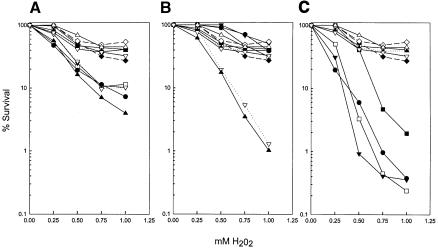Figure 1.
Deletion of the RAD1 and RAD10 genes, but not of other NER genes, enhances the H2O2 sensitivity of the apn2Δ strain. (A) Effect of deletions of NER genes on the H2O2 sensitivity of the apn1Δ strain. (○) Wild type; (▪) apn1Δ; (- -♦- -) rad1Δ; (- -⋄- -) rad2Δ; (----▴----) rad4Δ; (▵) rad10Δ; (▿) rad14Δ; (----▿----) apn1Δ rad1Δ; (□) apn1Δ rad2Δ; (▾) apn1Δ rad4Δ; (▴) apn1Δ rad10Δ; (•) apn1Δ rad14Δ. Because of their similar H202 sensitivities, the wild-type strain and some of the single mutant strains cannot be distinguished from one another. (B) Effect of deletion of NER genes on the H2O2 sensitivity of the apn2Δ strain. Symbols as in A except that apn2Δ instead of apn1Δ is combined with the radΔ mutations. Only the sensitivity of the apn2Δ rad1Δ (----▿----) and apn2Δ rad10Δ (▴) is greatly enhanced. (C) Effect of deletions of NER genes on the H2O2 sensitivity of the apn1Δ apn2Δ strain. (○) Wild type; (- -♦- -) rad1Δ; (- -⋄- -) rad2Δ; (----▴----) rad4Δ; (▵) rad10Δ; (▿) rad14Δ; (▪) apn1Δ apn2Δ; (□) apn1Δ apn2Δ rad2Δ; (▾) apn1Δ apn2Δ rad4Δ; (•) apn1Δ apn2Δ rad14Δ.

